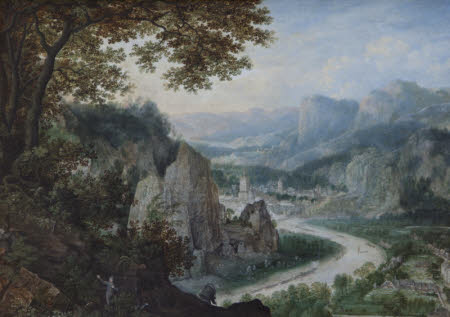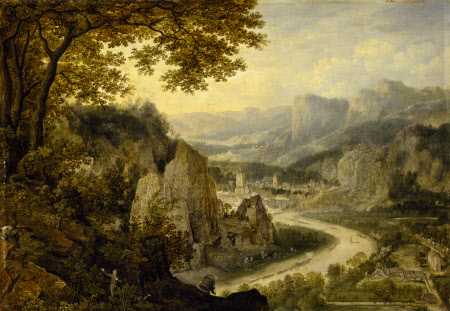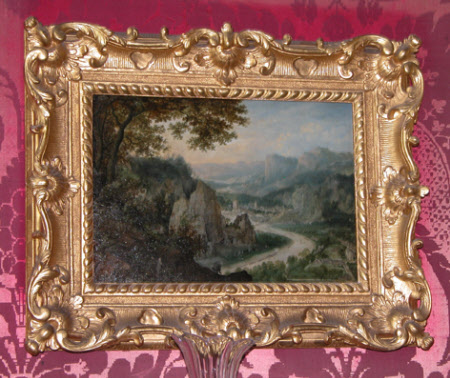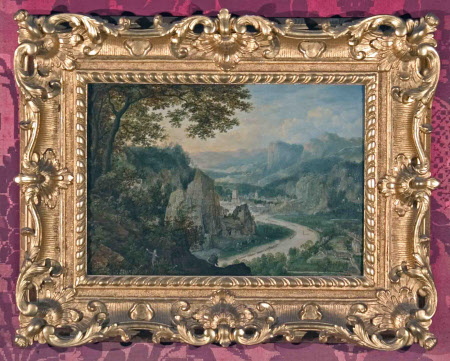A View on the Meuse with Miners
Lucas van Valckenborch (Louvain c.1535 – Frankfurt am Main 1597)
Category
Art / Oil paintings
Date
1555 - 1597
Materials
Oil on panel
Measurements
445 x 311 mm (12 1/4 x 17 1/2 in)
Place of origin
France
Order this imageCollection
Felbrigg, Norfolk
NT 1401167
Caption
The Valley of the Meuse was a cradle both of industry and of pure landscape-painting in Europe. Lucas and his younger brother Marten fled the religious upheavals and repression in Antwerp for Liège there in 1567. The dramatic contrasts of the mountainous scenery around it evoked those of the fantastic Alpine landscapes engraved from Pieter Bruegel's drawings after his Italian journey of 1553, and inspired Lucas to paint actual and imaginary views of it, into which he introduced depictions of coal-mining and iron-foundries. This picture comes from the perfectly-preserved Cabinet that William Windham created a decade after his return from an extended Grand Tour in 1742.
Summary
Oil painting on panel, A View on the Meuse with Miners by Lucas van Valckenborch (1535-97), bears inscription, lower left, on the rock: 'P. Brill'. A river winding through dramatic landscape, town in distance. Scene of open-cast coal mining. Identified as by Valckenborch by Jacques Stiennon, 1954.
Full description
It is ironic that one of the cradles of landscape-painting in Europe should also have been the hearth of the human activities that have probably since despoiled more landscape than any others: coal-mining, and the iron and steel industries that were naturally associated with this. Yet there may have been a more intimate connection between the two than might at first appear. One the one hand, the exceptional nature of the activities involved in mining and forging, and the fact that these had - at least in their infancy - picturesque qualities of their own, may have encouraged the depiction of landscapes with them in, particularly as landscape-painting was emancipating itself from the need for religious pretexts, such as the Flight into Egypt, or the Temptation of St. Antony. On the other - though this is entirely unproven so far - mining and industry, by encouraging capital formation, may have helped to create a clientele with excess capital to spend upon a superfluity such as art, but which at the same time liked to see its familiar surroundings and activities reflected in what it bought for private enjoyment and display, rather than for religious or other public function. The present picture, which up until 1954 had been identified as A View on the Danube by Paul Brill, whose false signature it bears (despite the facts that that artist never worked by that river, nor ever treated it in his paintings), was first recognised as an early work of Lucas van Valckenborch by the Rijksbureau voor Kunsthistorische Documentatie in the Hague, and published in 1954 by Jacques Stiennon . It was subsequently, and plausibly, identified as a View on the Meuse - although whether of a single site, or of a conflation of sites, remains to be established. Although the setting is structured somewhat like that of the Magdalena Poenitens in Pieter Brueghel's set of engravings known as the Large Landscapes, but in reverse , it is in no sense an imitation of this. Brueghel's example in this and other engravings may, however, have encouraged Valckenborch to exaggerate the mountainous character of the terrain. It is certainly the case that, when Valckenborch fled from Malines after the Bildersturm of 1566, in the summer of 1567, he went first to Liège, and then to Aachen, and seems to have been so struck by the scenery around it and other towns on the Meuse, that he recorded it in a number of pictures, that he painted both at the time and subsequently in Antwerp, after his temporary return to Flanders in the second half of the 1570s. These views are already recorded by Carel van Mander in his Schilderboek (1604), who says that the Valckenborch brothers and Hans [Vredeman] de Vries: "went to Aachen and Liege, where they worked a lot from nature, since the banks of the Meuse and the environs of Liege afford many fine views. Since they were also all skilful perfumers on the German flute, the three of them enjoyed themselves greatly" Lucas van Valckenborch seems to have been equally struck by the activities of coal-mining and iron-founding that went on in the region, since he introduced miners and mines not only into his Views, but also into representations of subjects such as the Tower of Babel, or the Crucifixion . They were activities that continued to fascinate him throughout his life, since he also included them in some of the pictures that he painted as a Court Painter to the Archduke Matthias in Linz (1582-93) - although whilst there he seems to have taken fresh inspiration from the iron-foundries of Styria , and he probably repeated some of these depictions during his last four years in Frankfurt. He was not the first artist to include portrayals of these activities; they are already to be found in certain paintings by Herri met der Bles (c.1510-1550/55) of Bouvignes near Dinant - which was also on the Meuse, and a centre of metalwork - and by Lucas Gassel (c.1500/10-after 1568) of Helmond, who operated in Brussels; but he did so with surprising frequency. In the present picture, the depiction is restricted to that of the two miners in the foreground, one already making his way downwards with the hod on his back, with what is possibly a line of coal-barges on the river. Valckenborch's subsequent portrayals - particularly of ironworks - are much more extensive. There may even have been a dim memory of Valckenborch's time in Liège, and of the pictures that he spun out of this experience, in the story told by Edward Norgate, of the lover of art "returning from a long journey he had made about the Countrey of Liege and Forrest of Ardenna", who inspires a painter in Antwerp to portray their scenery by his enthusiastic descriptions of it. Norgate certainly, though not specifically naming Valckenborch, seems to have had a particular fondness for both the limned landscape and the kind of landscape with mountains that he practised . Charles I's collections contained no less than four pictures by Valckenborch. None was a pure landscape, but one - bought for the King by Sir James Palmer, the father of the Earl of Castlemaine - showed an identifiable view: "a Lanskipp peece where Christ is tempted of the divill to make the Stones bread, whereby the river rine is painted - the ratts towres wer the Busshop thought to have Saved himself from the ratts" - i.e. the Mäuseturm, near Bingen on the Rhine . Pleasant though it would be to imagine that the present painting is one of those originally collected by English 'Liefhebbers' of Valckenborch in the 17th century, its installation in the Cabinet at Felbrigg makes this less likely. For virtually every painting in this room appears to have been acquired by William II Windham (1717-61) when on the Grand Tour (1738-42); this particular one is one of those inscribed on the diagrammatic picture-hangs that he had drawn up in early 1752. " . The ascription to the Rome-based Paul Brill might mean that Windham had acquired the picture in that city, like the twenty-six gouaches of the Roman Campagana by G.B. Busiri that are its chief ornament, and whose scale matches that of the Brill. But Windham spent much more of his time abroad in Geneva, where he formed a 'Common Room' with a group of other English travellers and their tutors, and where he contracted a clandestine engagement with a génévoise, and he also seems to have bought pictures on his return through the Low Countries in 1742. The frame on the picture is one of a whole set, of differing Rococo patterns, made for this room and for the Great Parlour (now the Drawing Room), probably by the Huguenot René Duffour of Soho, better-known as a supplier of papier-mâché ornament . The room as a whole is an epitome of the Grand Tour, devotedly preserved (all but its furniture) by the successive families that inhabited it. Hist: presumably acquired by William II Windham (1717-61) - first recorded on his hanging-plan for the Cabinet at Felbrigg in 1752; thence by descent (and once by purchase, when John Ketton bought the estate from the banker of the bankrupt William Frederick 'Mad', Windham, in 1863), until 1969, when estate, house, and all its contents were bequeathed to the National Trust by Robert Wyndham Ketton-Cremer (1906—1969). Exh: 17th Century Art in Europe, Royal Academy, London, 1938, no.63 [as: View on the Danube, by Paul Brill]; Flemish Art, Royal Academy, London, 1953, no.304 [as the same]; Fine Paintings from East Anglia, Castle Museum, Norwich, 1964, no.73 by Lucas van Valckenborch; Between Renaissance and Baroque, City Art Gallery, Manchester, 1965, no.230 [as: View on the Meuse by Lucas van Valckenborch]; Dutch and Flemish Painting in Norfolk, Castle Museum, Norwich, 1988, no.38 [as: A View on the Meuse by Lucas van Valckenborch]. Lit: Jacques Stiennon, Les sites Mosans de Lucas I et Martin I van Valckenborch, Société des Beaux-Arts de Liège, 1954, p.21, no.34 [as: Paysage rocheux, by Lucas I van Valckenborch]; Alexander Wied, Lucas und Marten van Valckenborch, Freren, 1990, pp.136-37, no.14 [claiming that the background is overpainted, of which no indication has emerged in conservation]. (i) Les sites Mosans de Lucas I et Martin I van Valckenborch, Société des Beaux-Arts de Liège, p.21, no.34. (ii) Cf. F.W.H. Hollstein, Flemish Etchings and Woodcuts, vol.III, p.256. (iii) Le Livre des peintres de Carel van Mander, trans. Henri Hymans, Paris, vol.II (1885), pp.47-48. For particular examples, cf. Alexander Wied, Lucas und Marten van Valckenborch, Freren, 1990, nos.2, 3, 8, 11, 14 [this picture], 18, 23, 27, 30, 40, 41, 42, &c. (iv) Mining and/or iron foundries feature in most of the landscapes enumerated in the previous footnote. They, or figures associated with them, also appear in Wied, nos.6, 7, 66, & 82. (v) Or so Wied suggests, op.cit., p.15, col.1. (vi) Herri met der Bles's Landscape with mines and forges exists in a number of versions, of which the prime one would seem to be that in the Uffizi (cf. Heinrich Winkelmann, Der Bergbau in der Kunst, Essen, 1958, pp.84-86 & pl.43); others are in the Galleries of Prague, Vienna, Budapest and Graz. (vii) Notably the signed and dated painting of 1544 in the Musée Royaux in Brussels (Winkelmann, op.cit., p.86 & pl.44). (viii) Cf. Henry & Margaret Ogden, English Taste in Landscape in the Seventeenth Century, Ann Arbor, 1955, -pp.8-15 & 44- 45. (ix) Cf. 'Abraham van der Doort's Catalogues of the Collections of Charles I', ed. Oliver Millar, The Walpole Society, vol. XXXVII, 1958—60 [1960], p.160, no. [5]. (x) or William II Windham, his Grand Tour, and his Cabinet, see: R.W. Ketton-Cremer: Felbrigg:The Story of a House, London, 1962 [reissued, Ipswich 1976], pp.112-58; Francis Harcroft, "The "Cabinet' at Felbrigg", The Connoisseur, May 1958; John Maddison, Felbrigg Hall, The National Trust, 1995, in which the plan for the picture-hang of the chimneypiece wall is reproduced on p.58. (xi) There are also some papier-mâché frames at Felbrigg; it could be that it was these that René Duffour supplied, and that the carved frames were made in situ by Thomas Quintin, who is documented as working at Felbrigg on architectural carvings and gilding between March 1751 and May 1753; but the pictures were only sent down from London in July 1752, so this is unlikely. René Duffour appears to have been the son of Frederick Prince of Wales's picture-frame-maker, Joseph Duffour, and subsequently to have changed his name to Stone, since by about 1765 a René Stone was working from what had been the Duffours' address, at the Golden Head in Berwick Street, Soho (cf. Geoffrey Beard, Craftsmen and Interior Decoration in England 1660-1820, Edinburgh, 1981, p.257; exh. cat. The Quiet Conquest:The Huguenots 1685 to 1985, The London Museum, 1985, p.202, no.292. (adapted from the author's pre-publication/unedited version of Alastair Laing, In Trust for the Nation, exh. cat. 1995)
Provenance
Bought by William Windham II (1717 - 1761) as 'View on the Danube by Paul Brill', around 1751-2, and described thus in the 1764 inventory; thence by descent to Robert Wyndham Ketton-Cremer (1906 - 1969), by whom bequeathed to the National Trust in 1969
Makers and roles
Lucas van Valckenborch (Louvain c.1535 – Frankfurt am Main 1597), artist previously catalogued as attributed to Paul Bril (Antwerp 1554 - Rome 1626), artist
Exhibition history
In Trust for the Nation, National Gallery, London, 1995 - 1996, no.57
References
Steinnon 1954 J. Steinnon Les sites mosans de Lucas I et Martin I van Valckenborch. Essai d'identificatiion, Liége, 1954, p. 21, no. 34




